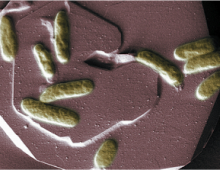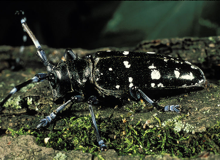Cyanobacteria’s ability to capture solar energy and fix CO2 holds promise for biotech applications The Science Researchers studied 10 different cyanobacteria to identify their secondary metabolites (compounds produced during normal cellular metabolism not directly involved in cell growth, that may play an important role in interactions outside the cell) and the genes linked to those…
DOE JGI Science Highlight: The inner workings of cyanobacteria carbon fixation
New research upholds theoretical structure for cyanobacteria carboxysomes. The Science Researchers described the structure of a protein critical to the outer shell of carboxysomes, the organelle-like structure that cyanobacteria use for carbon fixation. The Impact The structure and interaction of the proteins that make up the carboxysome’s outer shell aren’t clearly understood. A detailed study…
Cold, Salty and Promiscuous—Gene-shuffling Microbes Dominate Antarctica’s Deep Lake
Sequestered in Antarctica’s Vestfold Hills, Deep Lake became isolated from the ocean 3,500 years ago by the Antarctic continent rising, resulting in a saltwater ecosystem that remains liquid in extreme cold, and providing researchers a unique niche for studying the evolution of the microbes that now thrive under such conditions. Deep Lake’s microscopic inhabitants are…
Analyzing the Role of DNA Methylation in a Bioremediation Bacterium
Characterizing functional roles in a microbe with bioremediation applications a first step toward similar studies for other prokaryotes The Science Researchers studied the role of DNA methylation on gene expression and other processes in the heavy-metal reducing bacterium Shewanella oneidensis MR-1 with the help of next-generation Single-Molecule Real Time (SMRT) sequencers from Pacific Biosciences. The…
Microbial dark matter study in Wired
“The idea was to go after underrepresented branches of microbial diversity – so-called Microbial Dark Matter – for which additional information would have a disproportionately large effect on the tree’s overall shape. In pursuit of these recluses, Rinke and his colleagues sampled nine different habitats that were likely to house exotic or otherwise overlooked organisms:…
Yellowstone Hot Springs: A Hotbed of Microbial Life
[Note: This article originally appeared in the Autumn 2013 issue of the JGI Primer.] Life on Earth finds a way to survive almost anywhere there is a source of energy to support it. In Yellowstone National Park (YNP), this phenomenon is in the extreme by microorganisms that thrive in harsh, acidic hot springs found unsuitable…
Beetle gut microbes bore through woody tissues
Profile of wood-boring beetle’s midgut microbial community identifies candidate genes involved in processes including lignin degradation The Science Metagenomics allowed researchers to conduct a functional analysis of the midgut microbial community in the Asian longhorned beetle (Anoplophora glabripennis), an invasive insect that feeds on lignin in deciduous trees such as poplars and willows. The Impact…
POPSEQ for Plant Genome Assembly
New approach allows researchers to work on many species regardless of sequence resources The Science Plant genomics researchers evaluated POPSEQ, a method for assembling complex plant genomes using next-generation sequencing. The Impact Using a large, complex and highly-repetitive plant genome, the findings yielded results comparable to the previously assembled sequence. The proof of principle demonstrates…
Subsurface Sediment Yields Novel Organism
Metagenomic analysis emphasizes the “extraordinary microbial novelty” of poorly-explored subsurface ecosystems The Science Through metagenomics, researchers reconstructed a dominant organism and member of a new phylum-level lineage from an aquifer sediment in Colorado. The Impact Analysis of the complete microbial genome led to a detailed metabolic model with evidence for multiple new enzymes and pathways….
Microbial dark matter study in Treehugger
“Space comes to mind as the last frontier for finding new forms of life, but we still have not explored all of the planet on which we are living. Biologists venture to places both extreme and mundane in the quest to learn more about Earth. Courtesy of the DOE Joint Genome Institute, here is a photo…







